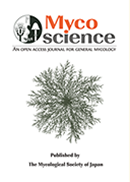55 巻, 3 号
選択された号の論文の12件中1~12を表示しています
- |<
- <
- 1
- >
- >|
Short communication
-
2013 年 55 巻 3 号 p. 159-163
発行日: 2013年
公開日: 2023/03/07
PDF形式でダウンロード (1083K)
Note
-
Analysis of indole compounds from the fruiting bodies and the culture mycelia of Sarcodon imbricatus2013 年 55 巻 3 号 p. 164-167
発行日: 2013年
公開日: 2023/03/07
PDF形式でダウンロード (344K)
Full paper
-
2013 年 55 巻 3 号 p. 168-176
発行日: 2013年
公開日: 2023/03/07
PDF形式でダウンロード (1948K)
Short communication
-
2013 年 55 巻 3 号 p. 177-182
発行日: 2013年
公開日: 2023/03/07
PDF形式でダウンロード (1583K)
Full paper
-
2013 年 55 巻 3 号 p. 183-189
発行日: 2013年
公開日: 2023/03/07
PDF形式でダウンロード (719K) -
2013 年 55 巻 3 号 p. 190-195
発行日: 2013年
公開日: 2023/03/07
PDF形式でダウンロード (1189K) -
2013 年 55 巻 3 号 p. 196-212
発行日: 2013年
公開日: 2023/03/07
PDF形式でダウンロード (5251K) -
2013 年 55 巻 3 号 p. 213-220
発行日: 2013年
公開日: 2023/03/07
PDF形式でダウンロード (1725K) -
2013 年 55 巻 3 号 p. 221-226
発行日: 2013年
公開日: 2023/03/07
PDF形式でダウンロード (1068K)
Note
-
2013 年 55 巻 3 号 p. 227-230
発行日: 2013年
公開日: 2023/03/07
PDF形式でダウンロード (1577K)
Full paper
-
2013 年 55 巻 3 号 p. 231-239
発行日: 2013年
公開日: 2023/03/07
PDF形式でダウンロード (1105K)
Erratum
-
2013 年 55 巻 3 号 p. 240
発行日: 2013年
公開日: 2023/03/07
PDF形式でダウンロード (170K)
- |<
- <
- 1
- >
- >|
